
Walled Lake History
Pioneering West
Northwest Ordinance
The Northwest Ordinance of 1789 granted the United States control over the Northwest Territory, an area stretching between the Mississippi and Ohio Rivers that included present-day Ohio, Michigan, Indiana, Illinois, and Wisconsin. One of its key provisions was the prohibition of slavery in these regions, establishing a clear division between slave states and free states. Mannaseh Cutler, a pioneering figure from Marietta, Ohio, and a key drafter of the ordinance, played a crucial role in advocating for a slavery-free territory.
The Northwest Ordinance sparked a westward migration from the original U.S. colonies, with Ohio becoming the first major destination due to its fertile land in the Ohio River Valley. Rufus Putnam, a key pioneer in the Northwest Territory, founded the "New Ohio Land Company," which purchased bounty land warrants from Revolutionary War veterans. These warrants, given as payment for military service, originally valued the land at $1.25 per acre. Putnam and his company acquired the land from veterans at deeply discounted prices, later reselling it for profit. In many ways, Putnam can be considered one of America's earliest real estate investors.
Initially, the government only sold land in 640-acre parcels, which made it unaffordable for most early American families. However, when Congress noticed the significant profits being made by land companies, they adjusted the policy, allowing smaller 80-acre sections to be sold at $1.25 per acre.
Tiffin Report
In 1814, General Edward Tiffin was appointed Surveyor General of the Northwest Territory, with the responsibility of exploring the newly acquired land to assess its potential for settlement and cultivation. A man of many roles, Tiffin was also a medical doctor and the former governor of Ohio. His mission included traversing the uncharted terrain of Michigan in search of land suitable for settlement by veterans of the War of 1812. In a letter to Joseph Meigs, Commissioner of the General Land Office, Tiffin wrote:
“I think it is my duty to give you this information, believing that it is the wish of the government that the soldiers should have lands fit for cultivation, and the whole of two millions of acres appropriated in the territory of Michigan will not contain anything like one hundredth part of that quantity, or is worth the expense of surveying it…”
“The intermediate space between these swamps and lakes--which is probably near one-half of the country--is, with very few exceptions, a poor, barren, sandy land, on which scarcely any vegetation grows, except very small, scrubby oaks. In many places, that part which may be called dry land is composed of little, short sand-hills forming a kind of deep basins, the bottoms of many of which are composed of marsh similar to the above described. The streams are generally narrow, and very deep compared with their width, the shores and bottoms of which are, with very few exceptions, swampy beyond description; and it is with the utmost difficulty that a place can be found over which horses can be conveyed in safety.”
“Taking the country altogether, so far as it has been explored, and to all appearances, together with information received concerning the balance, it is so bad that there would not be more than one acre out of a hundred, if there would be one out of a thousand, that would in any case admit of cultivation.”
General Tiffin, as mentioned, concluded that the Michigan Territory was entirely unsuitable for cultivation, with its vast marshes, swamps, and dense, untamed vegetation dominating the landscape. As a result, Congress redirected land surveying efforts from Michigan to Mississippi, shaping a perception of Michigan’s lands as uninhabitable—an image that may still linger in some American minds today.
The Detroit Gazette and Pontiac Company made tremendous efforts to counter this stigmatization. The Detroit Gazette published articles describing the beauty of Michigan; from the plentiful blue lakes supporting wildlife, to the fertile soil for farming. The Pontiac Company sent representatives to New York to disseminate information regarding this territory that was hitherto travelled by Americans. This venture proved successful, as many Americans soon after began their expeditions westward, drawn by the promise of opportunity in Michigan.
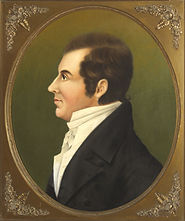
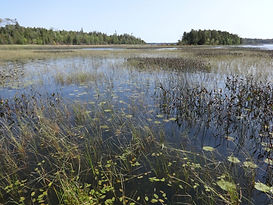
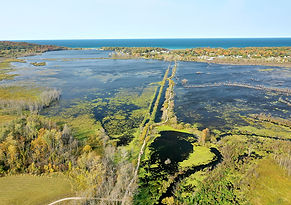
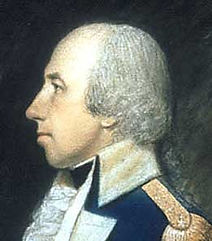


Rufus Putnam
Northwest Territories
Manasseh Cutler
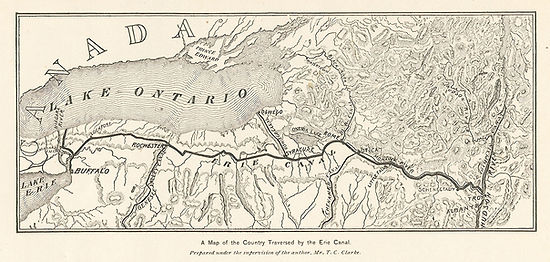
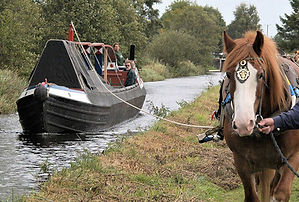
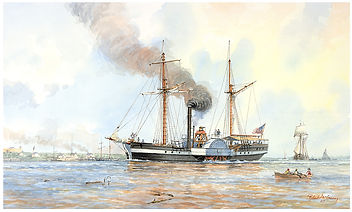
Packet boat being pulled by horse
Artist rendition of the "Walk-in-the-Water" steamboat
Erie Canal
The original pioneers heading west often brought their families to Pittsburgh, where they would board boats to travel along the Ohio River. Many families established permanent settlements along the river, including Marietta, Ohio, which became the first settlement in the Northwest Territory. Others continued further westward into what was known as the Ohio Country.
In the early 19th century, most Michigan pioneers traveled west from New York, Pennsylvania, and New England aboard small schooners departing from Buffalo. They reached Buffalo by stagecoach, traversing the Mohawk and Genesee turnpikes across New York State. After arriving in Detroit, they continued their trek westward on horseback, navigating through dense forests and tangled swamps to reach the interior. This arduous journey typically took around 30 days.
The boats traveling from Buffalo to Detroit gradually became larger and more advanced. In 1818, the first steamboat on Lake Erie, named "Walk-in-the-Water," made its debut. The vessel earned its name after a Huron chief commented that it appeared to "walk" as it glided across the water.
On October 26th, 1825, the Erie Canal opened, becoming the first "superhighway" of the New World. This vital waterway connected the Atlantic Ocean to the Great Lakes, significantly easing travel and the shipping of goods, effectively boosting the economy of the settlements along its route. The canal played a crucial role in the westward migration to Michigan, reducing the travel time from Albany to Detroit from thirty days to around ten.*
Many settlers radiated out from Detroit, establishing communities along smaller tributaries in places like Northville, Farmington, Pontiac, Ann Arbor, and Commerce. They traversed indigenous trails, which were often overgrown with thick brush and fallen trees due to infrequent use. This made the cumbersome travel by horseback and wagon that much more challenging. Many pioneers carried axes and hatchets to chop and clear the paths as they made their way to their new settlement.
Notes:
*The Erie Canal was 363 miles in total. The packet boats were pulled by horses or donkeys at 2 miles per hour. If one were to start at the beginning of the canal, it would take 7.56 days to complete. From here Buffalo to Detroit it would take nearly 3 days to complete, totaling the trip at around 10.56 days.
References
1. “United States Migration to Ohio, Northwest Territory, Southwest 1785 to 1840 - International Institute.” FamilySearch Wiki, FamilySearch Wiki, 27 Apr. 2023, www.familysearch.org/en/wiki/United_States_Migration_to_Ohio,_Northwest_Territory,_Southwest_1785_to_1840_-_International_Institute.
2. “Object 2: Bounty Land Warrant.” VA History, 10 Aug. 2023, department.va.gov/history/100-objects/object-2-bounty-land-warrant/#:~:text=The%20amount%20of%20land%20varied,1%2C100%20acres%20for%20major%20generals.
3. McGreevy, Robert (August 2018). "Walk-in-the-Water". The Lakeshore Guardian. Harbor, Beach, Michigan, serving Huron, Sanilac, St. Clair, and Tuscola Counties, Michigan. Retrieved October 1, 2019.
4. “Traveling on the Erie Canal.” Michiganology, 1 Sept. 2021, michiganology.org/stories/traveling-on-the-erie-canal/.
5. Durant, Samuel W. History of Oakland County, Michigan. L. H. Everts & Co, 1877.
6. Severance, Henry Ormal. The Story of a Village Community. G. E. Stechert & Co, 1931.
7. The Tiffin Report, www.pittsfield-mi.gov/1298/The-Tiffin-Report. Accessed 18 Sept. 2024.
